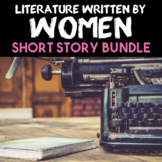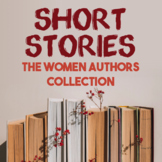Desiree’s Baby by Kate Chopin | Short Story Analysis
Chomping at the Lit
5.6k Followers
Grade Levels
8th - 12th, Higher Education, Adult Education, Homeschool
Subjects
Resource Type
Standards
CCSSRL.8.1
CCSSRL.8.2
CCSSRL.8.3
CCSSRL.8.4
CCSSRL.8.10
Formats Included
- Zip
Pages
13 pages
Chomping at the Lit
5.6k Followers
Also included in
- This bundle includes five short stories by women authors—perfect for celebrating Women's History Month and diversifying literature in your classroom. These stories fit nicely into any short story unit for high school or upper middle school students. The Yellow Wallpaper by Charlotte Perkins GilmanDePrice $7.99Original Price $9.95Save $1.96
- The Female Authors Collection — 15 Short Stories Written by Women, perfect for Women's History Month!1) The Hitchhiker by Lucille Fletcher 2) Fish Cheeks by Amy Tan3) Geraldine Moore the Poet by Toni Cade Bambara4) The Scholarship Jacket by Marta Salinas5) The Third Wish by Joan Aiken6) The Yellow WPrice $19.99Original Price $29.85Save $9.86
Description
“Désirée’s Baby” is a short story by Kate Chopin published in 1893. The story is set in Louisiana during the mid-nineteenth century, or the Antebellum South period. At the time, rich, white slaveowners were at the top of the social hierarchy. This story intertwines themes of racism and sexism through a complex plot and development of characters.
Included in this purchase is:
- Complete short story “Désirée’s Baby” by Kate Chopin
- Academic vocabulary graphic organizer
- Activating prior knowledge activity based on the historical context
- Brief background information for students to build on prior knowledge
- Literary Analysis questions where students will:
- Analyze how an author’s choices concerning how to structure specific parts of a text (e.g., the choice of where to begin or end a story, the choice to provide a comedic or tragic resolution) contribute to its overall structure and meaning as well as its aesthetic impact.
- Analyze how complex characters develop over the course of the text
- Cite the textual evidence that most strongly supports an analysis of what the text says explicitly as well as inferences drawn from the text.
- Analyze literary elements such as irony, foreshadowing, and character motivations.
- Constructed response question where students will:
- Determine theme and how it emerges and shaped by specific details.
- Determine two or more themes or central ideas of a text and analyze their development over the course of the text, including how they interact and build on one another to produce a complex account; provide an objective summary of the text.
- Answer keys
File Types Included:
Teacher Guide and Answer Keys (PDF)
Student Copy of Activities (Word document—editable for teachers)
Student Copy of Activities (PDF—ready to print)
You May Also Like!
Total Pages
13 pages
Answer Key
Included
Teaching Duration
4 days
Report this resource to TPT
Reported resources will be reviewed by our team. Report this resource to let us know if this resource violates TPT’s content guidelines.
Standards
to see state-specific standards (only available in the US).
CCSSRL.8.1
Cite the textual evidence that most strongly supports an analysis of what the text says explicitly as well as inferences drawn from the text.
CCSSRL.8.2
Determine a theme or central idea of a text and analyze its development over the course of the text, including its relationship to the characters, setting, and plot; provide an objective summary of the text.
CCSSRL.8.3
Analyze how particular lines of dialogue or incidents in a story or drama propel the action, reveal aspects of a character, or provoke a decision.
CCSSRL.8.4
Determine the meaning of words and phrases as they are used in a text, including figurative and connotative meanings; analyze the impact of specific word choices on meaning and tone, including analogies or allusions to other texts.
CCSSRL.8.10
By the end of the year, read and comprehend literature, including stories, dramas, and poems, at the high end of grades 6–8 text complexity band independently and proficiently.




